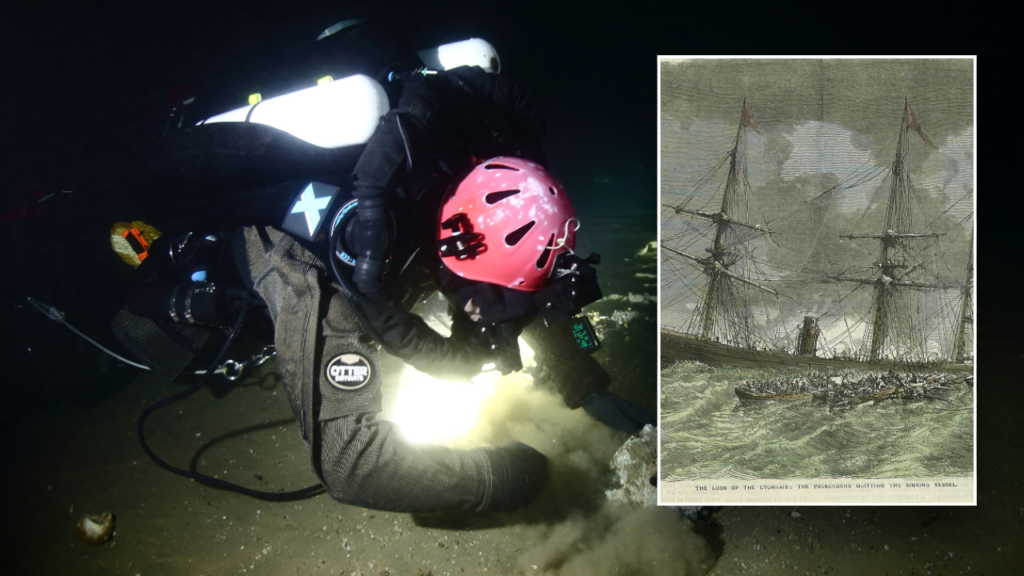Remarkable Discovery of the Steamship Le Lyonnais: A Journey into History
A team of committed researchers recently encountered an astonishing find — the steamship Le Lyonnais, a vessel that had been missing for an incredible 168 years. This remarkable discovery was publicly announced by Atlantic Wreck Salvage (AWS), a prominent maritime exploration organization known for its underwater excavation and recovery efforts. The shipwreck was located off the southeastern coast of Massachusetts, a region steeped in maritime history, adding layers of intrigue to the already fascinating tale.
The steamship Le Lyonnais was constructed in 1855, a time when maritime travel was undergoing significant transformations. However, despite its elegance and the promise of steam propulsion, the ship sailed for only a single year before meeting a tragic fate. On November 2, 1856, during its first return journey to Le Havre, France, the vessel collided with another ship known as the Adriatic. The Adriatic, albeit slightly damaged, continued its voyage, leaving Le Lyonnais with a critical hole in its hull. Tragically, the ship sank just days later, taking with it 114 lives out of the 132 passengers and crew aboard. The few survivors were left stranded in a lifeboat for an entire week, enduring unimaginable hardships as they awaited rescue.
Jennifer Sellitti, a representative from AWS, expressed her emotional response to this momentous discovery in an interview with Fox News Digital. She described the mixture of relief, joy, and a sense of curiosity about the future that enveloped her and her partner, Joe Mazraani, after years of searching for Le Lyonnais. Sellitti emphasized the personal significance of the find, stating that her long journey to uncover and share the stories of the ship and its passengers felt like a form of closure. “It’s about helping those who died so long ago to finally rest in peace,” she stated, highlighting the human connections that endure through time.
Her dedication to this maritime mystery was not without its doubts. Operating the D/V Tenacious, a vessel that specializes in wreck recovery, Sellitti anticipated challenges in locating Le Lyonnais. “The North Atlantic is notoriously brutal to shipwrecks,” she explained. Factors like raging storms, powerful currents, and shifting sands complicate the task of finding these submerged relics. She further noted that particular regions, like the Nantucket Shoals, often obscure wrecks from sonar detection, making the search that much more challenging. The researchers were also concerned that if they did manage to locate the ship, it might be found in depths exceeding one thousand feet, testing their rescue capabilities.
As a maritime enthusiast and aspiring author, Sellitti has composed a forthcoming book titled "The Adriatic Affair: A Maritime Hit-and-Run Off the Coast of Nantucket." Set to be released in February, the book will provide an in-depth exploration of the events surrounding the Le Lyonnais and broader implications during that transformative period of maritime history. The 1850s marked a critical juncture in shipping, characterized by a shift from wind-powered sailing vessels to steam-powered ships. This change brought with it a host of questions about maritime liability and international law — topics that shaped not only the shipping industry but also influenced global trade practices.
While Sellitti acknowledged that the state of Le Lyonnais has significantly deteriorated over time, she is eager to begin a meticulous documentation of the wreckage. “Shipwrecks are remnants of bygone eras,” she remarked, emphasizing the importance of these submerged artifacts as tangible connections to our past. Through such discoveries, historians and researchers can piece together stories that go beyond written accounts, creating a richer, more textured understanding of maritime history and its enduring impact.
In conclusion, the rediscovery of the steamship Le Lyonnais is not merely a tale of a ship lost to the depths of the ocean; it is a poignant reminder of the lives intertwined with its journey and the relentless curiosity that drives researchers to unveil the hidden narratives of our past. As Sellitti and her team embark on this new chapter of exploration, the echoes of history continue to resonate, bridging the gap between centuries and allowing us to bear witness to the resilient spirit of those who sailed before us.



